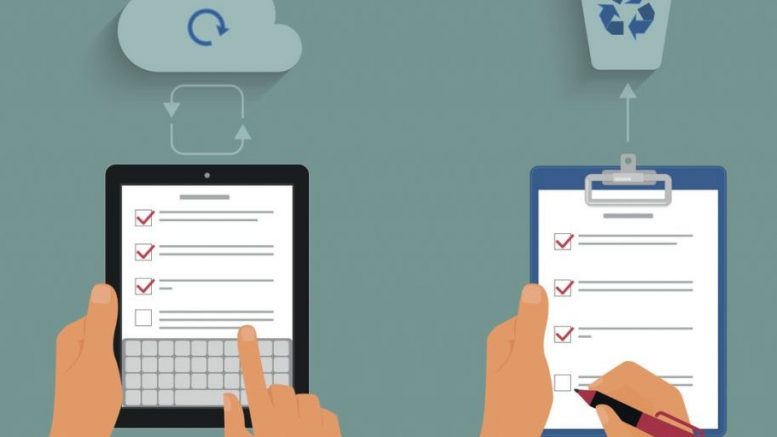As in so many other sectors, COVID-19 has shaken healthcare to the core, with social distancing measures largely putting an end, at least temporarily, to many of the physical face-to-face encounters that underpin much of medicine.
With clinics closed and many patients having to self-isolate, doctors working remotely and using technology more effectively will be one likely response to handling what we should think of as our new normality.
Since good clinical decisions and treatment are reliant on access to patient information that is complete, timely and accurate, there will be a growing urgency to connect patients digitally with their healthcare data.
One issue that lockdown has made clear, if it were not already, is the inadequacy of many systems, particularly those paper-based, which separate and contain information in a variety of different physical locations.
So, if we are to move quickly towards a healthcare environment in which patients are digitally ‘plugged in’ to a better healthcare experience, we need to expand the ways in which we are using technology.
The Royal Marsden’s Patient Portal is just one example of how this can be done, simply and effectively. By giving patients access through their mobile phone to personal health information, such as details of their outpatient appointments, clinicians’ letters, treatment notifications and information leaflets, the portal gives patients a much greater sense of involvement and control.
GOSH’s e-consent solution exemplifies the advantages of digital workflows
And wherever healthcare connects with patients, we need to be thinking digital. Let’s consider for a moment the humble consent form that is the trigger for countless treatments.
For somewhere such as Great Ormond Street Hospital for Children (GOSH), this could mean having to manage several sets of six-page individual consent forms, each of which would have to be printed and signed by relevant parties.
This might require getting signatures not just from parents, the child and attending doctors, but also interpreters, social services and secondary clinicians. On top of this, there may also be additional forms to complete for photography and MRI requests.
Once done, the signed forms would have to be scanned into the EPR system and the original written form shredded to maintain confidentiality.
Given that GOSH is one of the world’s leading paediatric hospitals, handling some 238,000 outpatient visits and over 43,000 inpatient visits every year, this is a significant data burden, irrespective of any other documentation being produced in the hospital.
Not only is this a costly and time-consuming process, but it also introduces inherent inefficiencies that could have a significant impact on patient outcomes.
For instance, once created, paper forms need to be categorised unambiguously and filed appropriately if they are not to be misplaced or lost.
Such a wasteful and problematic approach is not sustainable for any organisation that aims to deliver a better patient experience.
That’s why GOSH introduced e-forms that automatically reconfigure themselves, so they are ‘patient-specific’, with defined data fields automatically populated with previously given information from the EPR, so all that’s required is to capture signatures on a touchscreen device.
Having a single electronic form that changes dynamically, gives clinicians and other caregivers confidence that for any particular patient they will always be using the correct form.
GOSH is using Hyland’s OnBase platform integrated with Epic for their dynamic e-consent solution, which gives them the ability to incorporate not only the consent forms, but other unstructured content as well, into a single, complete, patient-centric record.
For everyone involved, this makes the form filling process faster and means that patients no longer have to provide the same information over and over again. And as GOSH has also found, both children and their parents feel they are more involved in their own care, because of the greater interactivity.
Such a system is also inherently safer since digital consent forms are inextricably linked to a patient’s record and so can’t be lost. They are also stored centrally, updated in real-time and consistently, which means everyone can be confident that what they are looking at is accurate, up-to-the-minute data.
Gong ‘digital-first’ reduces administrative burden, creates richer patient interaction
The introduction of e-consents is just one way that healthcare organisations can create a more digitally enabled environment for their patients and should be part of wider digital transformation.
Putting ‘digital first’ is widely recognised as a means to bring about longer, richer, face-to-face consultations with clinicians. And if confirmation of that were needed, COVID-19 has exposed all too clearly the flaws inherent in systems that use paper to capture and store information – no access to real-time data, not only affects clinical efficiency but can also heavily compromise the patient experience.
On the other hand, using this technology eliminates or automates many low-value back-office processes for doctors and administrative staff, and helps ensure that promises of ‘no decision about me, without me’ become a reality for more patients, which in turn will improve the patient-clinician experience.
So, if there is one good thing that results from the pandemic, COVID-19 could be the catalyst that accelerates the implementation of digital enablement into healthcare.
Peter Corscadden is Install Base Manager EMEA with Hyland Healthcare. www.hyland.com





